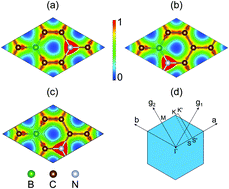Prediction of high carrier mobility for a novel two-dimensional semiconductor of BC6N: first principles calculations
Abstract
First principles calculations are performed to predict phonon-limited carrier mobility for a novel graphene-like semiconductor with BC6N stoichiometry. First, the electron–phonon interaction matrix element (EPIME) from the standard Wannier and polar Wannier interpolation schemes is used to investigate mobility. After considering the polarization, carrier mobility is greatly reduced, so polar optical phonon (POP) scattering plays an important role. At 300 K, the electron mobility for the most stable BC6N–B is predicted to be μx = 4.51 × 102–8.37 × 102 and μy = 8.35 × 102–1.22 × 103 cm2 V−1 s−1, while the hole mobility is estimated to be μx = 4.79 × 102–8.65 × 102 and μy = 9.19 × 102–1.28 × 103 cm2 V−1 s−1. Then, the longitudinal acoustic phonon deformation potential theory (LAP-DPT) is adopted to calculate the mobility, which leads to an overestimation for carrier mobility in polar semiconductors. Furthermore, the semiempirical model based on the POP scattering is also used to investigate the mobility. It is confirmed that the intrinsic mobility for BC6N is mainly determined by the Fröhlich interaction. The investigation provides a deep understanding of carrier transport properties. It is revealed that B and N co-doped graphene may become a promising material for application in nanoelectronic devices due to the excellent mechanical behavior, moderate direct band gap and high carrier mobility.

- This article is part of the themed collection: Journal of Materials Chemistry C Lunar New Year collection 2021


 Please wait while we load your content...
Please wait while we load your content...